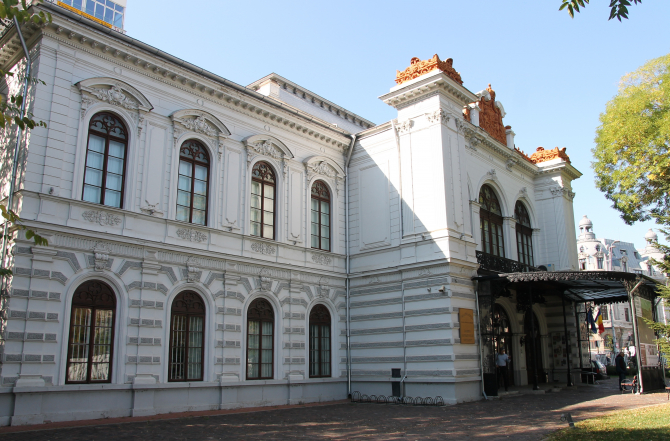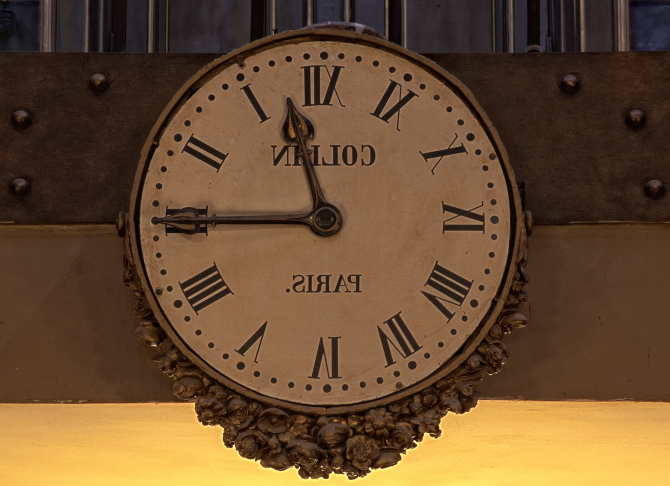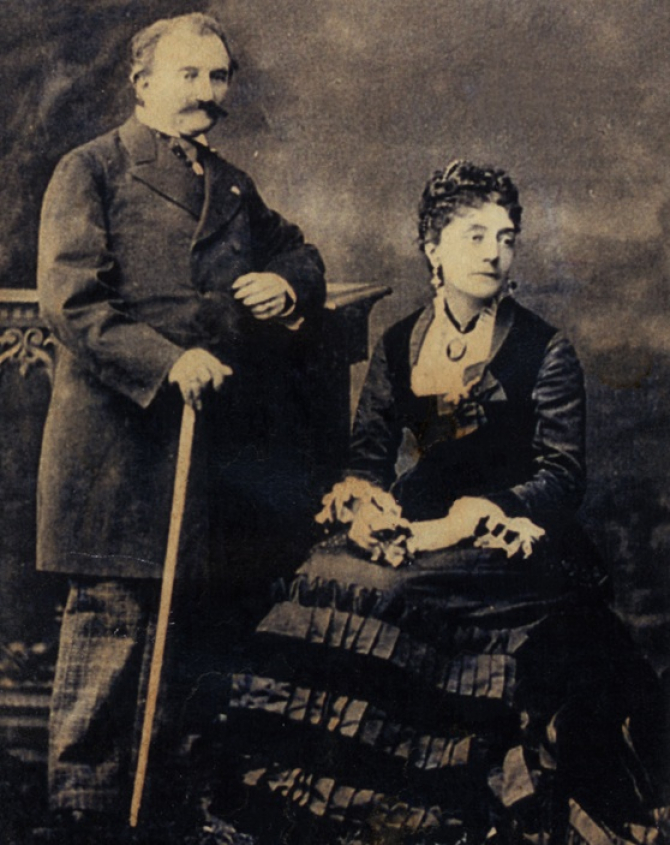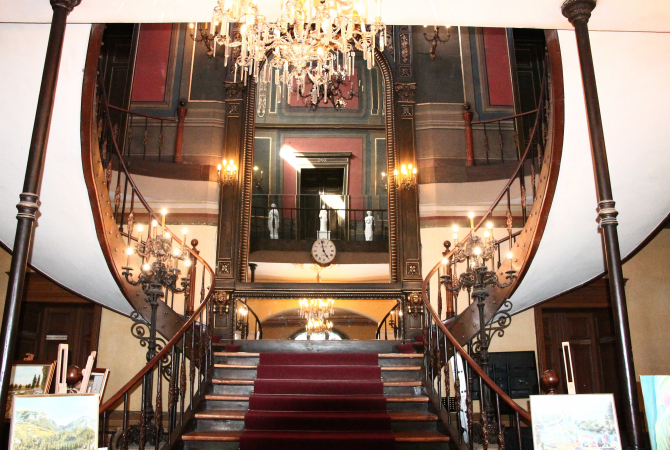
EXCLUSIV The Museum of Bucharest - or the Palace the Capital's secrets

The story of Șuțu Palace seems to come from another world. A story full of light and color, elegance and good taste. Few passers-by think today about the history of the building that guards the intersection of the University Square, but here was written a part of the story of Bucharest from its best times. A part that deserves to be known!
I had passed, perhaps, thousands of times around Șuțu Palace. I had entered for some exhibitions, several times. But I did not wonder why the interior staircase has a certain shape or why the large, crystal mirrors were placed where we can see them today. I didn't know many of the fascinating stories that I found one day, when curiosity pushed me further...

Cassette ceiling and chandelier in the great hall Photo: Municipal Museum of Bucharest
I went in that day to find out the story of the palace in the center of the Capital. And, step by step, I began to dream of a world of elegance and eccentrics from the late 19th century. Here, in the palace, only those who were part of the country's elite were invited to the Thursday ball. It couldn't enter anyone and... not anyway! It can be said that elegance was mandatory. At the dances, most of the ladies came with officers, and the dance teachers were offered „by the house”. The gentlemen could display all their assets here, in order to make conquests. This was the Șuțu Palace, in the center of Bucharest, at the end of the 19th century and the beginning of the 20th century.
The Romanian elites, invited to the ball
Here was invited the ruler Alexandru Ioan Cuza, then the members of the royal family and all the personalities of the time. It was the center of elegance and opulence, and an invitation to one of the famous dances that were organized here was equivalent to recognizing the importance that one had in the Romanian society of those times. The second half of the nineteenth century represented the period of maximum brilliance for the Șuțu Palace. The authors of this masterpiece were Grigore Șuțu (1819-1893) and his wife, Irina, the daughter of the great banker Stefan Hagi Moscu. The couple constantly took care of both the palace and the park around it. They added to the building the aisle supported by iron pillars, which created an elegant entrance porch. The park surrounding the palace was extended to the former place of St. Sava Church.

Clock, special order in Paris Photo: Municipal Museum of Bucharest
The story of the palace begins on March 29th, 1832. The architects Johann Veit and Conrad Schwinck were commissioned to build the Șuțu Palace, and the construction was completed, after a series of tensions and conflicts, including legal ones, in 1834. Built in neo-gothic style, with four polygonal turrets, placed two by two, on the sides, north and south, Șuțu Palace is noted for the spatiality of the interior, conferred by a dome similar to the one from the Golești mansion of the Șuțu family.
The decoration of the building continued until October 1836, when Costache Șuțu ordered the Austrian master Eser a brass candelabrum, made up of 24 candlesticks, just like the one at St. John's Church. The central hall was decorated in 1862 with the help of famous sculptor Karl Storck. He designed the three arches, the staircase with two arms and the mounting in the front wall of the mirror brought from Murano, caught in a frame. Above the mirror we can see even today Irina Șuțu's medallion, carved in wood.
The aristocratic couple: the Turk and the Camel
The legends of Bucharest say that the architecture of the palace and the interior design can be explained by the story of the couple Grigore and Irina Șuțu. The lovelace nobleman and his jealous wife divided the lobby into two equal parts, each side having a ladder, so that each of the two spouses took care of his or hers side of the ladder, when they were welcoming their guests. It is said that he, Grigore Șuțu, was smaller in stature and liked a lot all women, and the lady was taller and not quite beautiful - hence the nickname the couple had received in those times: the Turk and the Camel.

The Grigore family and Irina Șuțu Photo: Municipal Museum of Bucharest
The Ladies and the gentlemen went up separately the two stairs. Legend also says that Grigore Șuțu was attracted even to the women who served in the living room, and Irina Șuțu fired them all and brought older ones. The two stairs were raised after the construction of the building was completed, around 1864. Then a special order was made in Paris: a clock to be seen in the mirror, so that those who came to the ball to observe the time, while they were climbing.

Ladies and gentlemen climbed separately Photo: Crișan Andreescu
Elegance, opulence and barometer of social status
The outfit was compulsory and displayed an extraordinary elegance. The carriages came and were greeted by a white-clad fern with white gloves, who invited the ladies to enter the palace, and for the ladies who did not know how to dance, officers were hired to teach them the dance steps. The balls had something specific: no alcoholic beverages were served. Very rarely, champagne could be drunk here. In addition to the usual Thursday balls, the events were organized here also with various special occasions, such as winter holidays. The guests could walk through the magnificent garden of the palace, where peacocks and rare plants had been brought, behind the building that now houses the Municipal Museum of Bucharest.

Held from the balls organized on Thursday Photo: Crișan Andreescu
Each ball followed a preset schedule: the guests dined in the living room, then went up to the ballroom. In winter, the palace was very well heated. The stoves upstairs are still the original ones. There are countless stories about this palace, but some are very important for the history of the Romanians. In the conference room of the museum a gala lunch was organized, on the occasion of the New Year, in 1918, remaining in history for the discussion between the marshal August von Mackensen and Alexandru Marghiloman, for the urgent conclusion of the peace between Romania and the Central Powers.
Ten years later, the palace became the seat of the Bucharest City Hall. From his cabinet, in the room on the right of the large room with balcony, Dem I. Dobrescu signed the decision to open the first permanent exhibition of the Municipal Museum. Today, the Museum of Bucharest continues to tell to the visitors the fabulous story of almost two centuries of the Șuțu Palace and of the people who crossed its threshold.
Fiți la curent cu ultimele noutăți. Urmăriți DCNews și pe Google News








































